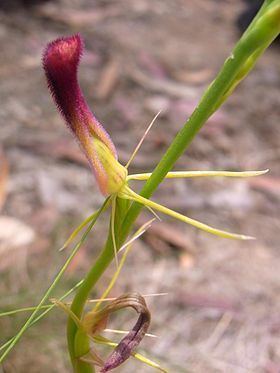Kingdom Plantae Family Orchidaceae Rank Species | Order Asparagales Genus Cryptostylis | |
 | ||
Similar Cryptostylis, Cryptostylis erecta, Cryptostylis subulata, Rhizanthella slateri, Genoplesium | ||
Cryptostylis hunteriana, commonly known as the leafless tongue-orchid grows in south eastern Australia. It is a rare species with a ROTAP rating of 3VC-
A small saprophytic plant growing to 45 cm (17.5 in) tall on sandy soils and heathlands, Cryptostylis hunteriana is found mostly in coastal districts, south from the Gibraltar Range National Park. It was originally collected by W. Hunter from near Marlo, Victoria. It was originally described by W.H. Nicholls in 1938.
The inflorescences (flower spikes) occur over the summer from November to February, each bears five to ten attractive red flowers, made up of a prominent spoon-shaped (spathulate) labellum which is a red or maroon in colour with a green base and is distinctly hairy. Measuring 2.2 to 3.3 cm (0.87 to 1.30 in) high and 0.6–0.7 cm wide, it has inrolled margins and a smooth underside. Thin green sepals measuring 1.8–2.2 cm (0.71–0.87 in) in length arise from its base. Like other Australian members of its genus, it is pollinated by the ichneumon wasp known as the orchid dupe wasp (Lissopimpla excelsa), the males of which mistake the flower parts for female wasps and copulate with it. Unlike other members of the genus, it lacks a leaf and is instead thought to have a relationship with a fungus for its metabolism.
Cryptostylis hunteriana is found in both wet heathland and in open areas lacking understory in dry sclerophyll forest, particularly with such trees as scribbly gum (Eucalyptus sclerophylla), silvertop ash (E. sieberi), red bloodwood (Corymbia gummifera) and black sheoak (Allocasuarina littoralis). It often grows near Cryptostylis subulata and C. erecta.
Cryptostylis hunteriana has been classified as vulnerable in both New South Wales and nationally, as it is uncommon and much of its distribution is threatened by urban development.
